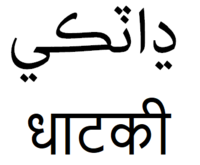Dhatki language
Dhatki (धाटकी; ڍاٽڪي), also known as Dhatti (धाटी; ڍاٽي) or Thari (थारी; ٿَري), is one of the Rajasthani languages of the Indo-Aryan branch of the Indo-European language family.[2] It is most closely related to Marwari.
| Dhatki | |
|---|---|
| धाटकी ڍاٽڪي Dhatki धाटीڍاٽي Dhatti थारी ٿَري Thari | |
 | |
| Native to | Pakistan and India (Marwar region of Rajasthan and Thar region of Sindh)(sociolect) |
Native speakers | (150,000 cited 2000)[1] |
| Devanagari, Mahajani, Arabic script | |
| Language codes | |
| ISO 639-3 | mki |
| Glottolog | dhat1238 |
SpeakersEdit
This section does not cite any sources. (July 2017) |
Dhatki/Dhati is spoken in western parts of Jaisalmer and Barmer districts & Southern part of Jalore district of Rajasthan, India and eastern parts of Sindh, Pakistan. Some Dhatki-speaking communities migrated to India in 1947 after the independence and continued to do so in small numbers after that date, but the great majority of Dhatki speakers still reside in Pakistan. Dhatki/Dhati is spoken by these communities:
- Thari Maheshwaris
- Rajputs
- Rajpurohit
- Charan
- Sodha
- Khatri
- Malhi
- Suthar
- Bajeer
- Sonara
- Meghwal
- Behil
- Harijan
- Garasiya
The majority speakers of Dhatki language live in Umerkot District and Tharparkar District in Sindh, Pakistan. 60% of the language's speakers are Muslims, 35% are Hindu and the remaining 5% practice traditional folk religions.
PhonologyEdit
Dhatki has implosive consonants, unlike other closely related Rajasthani languages but like the neighbouring (but more distantly related) Sindhi language. It is likely that these consonants developed in the language from contact with more culturally dominant Sindhi speakers. Aside from this, its phonology is much like other Indo-Aryan languages:
| Labial | Dental/ Alveolar |
Retroflex | Palatal | Velar | Uvular | Glottal | ||
|---|---|---|---|---|---|---|---|---|
| Nasal | m | n | (ɳ)1 | (ɲ)1 | (ŋ)1 | |||
| Plosive/ Affricate |
voiceless | p | t̪ | ʈ | tʃ | k | (q)1 | |
| voiceless aspirated | pʰ | t̪ʰ | ʈʰ | tʃʰ | kʰ | |||
| voiced | b | d̪ | ɖ | dʒ | ɡ | |||
| voiced aspirated | bʱ | d̪ʱ | ɖʱ | dʒʱ | ɡʱ | |||
| Implosive | voiced | ɓ | ɗ | ʄ | ɠ | |||
| Fricative | voiceless | f | s | (ʂ)1 | ʃ | (x)1 | ||
| voiced | z | (ɣ)1,2 | ɦ | |||||
| Flap | plain | ɾ | (ɽ)1 | |||||
| voiced aspirated | (ɽʱ)1 | |||||||
| Approximant | ʋ | l | ɭ | j | ||||
- Notes
- Marginal and non-universal phonemes are in parentheses. /ɽ/ is lateral [ɺ̢] for some speakers (Masica 1991:98).
- /ɣ/ is post-velar.[3]
Dhakti has a fairly standard set of vowels for an Indo-Aryan language: [ə aː ɪ iː ʊ (sometimes: u) uː eː oː ɛː ɔː]. The vowel ʊ may be realized as a short u and the vowel ɪ may be realized as a short i. The vowel ɛː is often realized as the diphthong əiː based and context or as an æː based on the speaker's accent. The vowel ɔː is often realized as the diphthong əuː based and context. Nazalized vowels occur word finally in Dhakti, they are: [ĩː ẽː ɛ̃ː ɑ̃ː ɔ̃ː õː ũː].
SamplesEdit
A few of the typical sentences in Dhatki are:
- [tu ki karin to?] "What are you doing?", [Hoon Ayye Pano Wachaan Payo] "I am reading this Page.",
- [tahayo naalo ki aheyy?] "What is your name?",
- [mana roti kharie aheyy] "I have to eat" (Literally translates to "I have to eat roti).
- [tu kith jaeen to?] "where are you going? [Kithe Kon Hi] "Nowhere.",
- [tu kin ahay?] "How are you?". [Hoon Theek Ahan] "I am Fine",
{Tu Kun ahi?}-"who are you?"
Writing SystemEdit
The language uses two major writing systems. In India, the Devanagari script (which is also used for Marwari, Hindi and many other north Indian languages) is employed; whereas is in Pakistan, the Sindhi script is used. Some mercantile families, particularly on the Indian side of the border use their own scripts, usually variations of the Mahajani script.
ReferencesEdit
- ↑ Dhatki at Ethnologue (18th ed., 2015)
- ↑ "Dhatki".
- ↑ Kachru (2006:20)